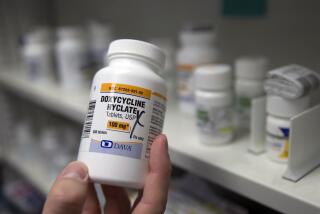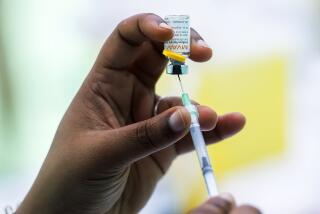Gonorrhea Rate in Gays Stirs AIDS Concerns
- Share via
Reversing a decades-long decline, the incidence of gonorrhea among gay males has begun to rise sharply, a sign of spreading unsafe sexual practices that may presage a new explosion of AIDS cases, federal authorities said Thursday.
The findings come as AIDS researchers are still flush with optimism from recent studies documenting falling rates of AIDS deaths and HIV infection in the United States. Now, the gonorrhea figures may suggest a massive “relapse” in sexual behavior among gay males, researchers say.
The incidence of gonorrhea not only serves as a good marker for the risk of HIV infection, but the disease itself also increases the risk that HIV will be spread from person to person.
Studies at 26 sexually transmitted disease clinics across the country show that the proportion of male gonorrhea victims who are gay increased 74% between 1993 and 1996, researchers from the Centers for Disease Control and Prevention report in the Morbidity and Mortality Weekly Report.
Among the eight such clinics with the highest percentage of gay males among gonorrhea patients were those in Orange County, Long Beach, San Diego and San Francisco.
Experts suggest that the increasing success of HIV treatment with triple-drug therapies has lulled gay men into a false sense of security that may lead to a disastrous recurrence of the AIDS increase observed in the early 1980s.
“This is really important, a wake-up call to all of us,” said Dr. Judy Wasserheit, director of the CDC’s Division of STD Prevention. The increases in the percentage of gay and bisexual males who have gonorrhea “are particularly alarming because they are superimposed on [other] national trends that speak to dramatic declines.”
Compared to other groups at risk of contracting AIDS, such as drug abusers, the biggest success story in reducing the disease’s spread in the past has been among gays, said Dr. Kim Fox of the University of North Carolina. “It seems particularly disheartening to see what may be a relapse in that community.”
But Fox cautioned that there is little other evidence to prove that gay men are reverting to dangerous behaviors. “There is a lot of talk about this in the lay press, but precious few data to support it,” she said.
Another concern is that the rise may indicate the possible onset of a gonorrhea epidemic, said Dr. Gary Richwald, director of the Los Angeles County Sexually Transmitted Disease Program. A gonorrhea epidemic in Los Angeles County in the 1980s, in which more than half a million extra cases were observed, was preceded by just such an increase among gay males, he said.
The county will increase the frequency of screening to determine whether “we are moving into the early phases of another epidemic,” Richwald said.
Gonorrhea is a common bacterial infection that is usually characterized by painful, burning urination and a pus-like discharge from the urethra or vagina. But as many as 90% of infected women and 60% of infected men show no symptoms, according to Richwald.
The overall incidence of gonorrhea in the United States has been dropping rapidly since 1975. Last year, according to the CDC, there were about 325,000 cases, down from 392,000 in 1995. “That is the lowest gonorrhea rate in the entire recorded history of gonorrhea surveillance,” Wasserheit said.
Authorities are concerned because the trend among gay males is in the opposite direction.
The new data come from a surveillance program designed to detect increased resistance to antibiotics by the bacterium that causes gonorrhea. Researchers at the 26 clinics collect specimens from the first 20 men who show up with gonorrhea each month and send the specimens and a medical history to the CDC.
In 1993, only 5% of male gonorrhea patients reported having sex with other men. By 1996, that proportion had grown to 8.7%--a 74% increase.
At the eight clinics with the highest incidence of gonorrhea among gay males, the proportion grew from 12% in 1993 to 23.5% in 1996, a near-doubling.
Although the nationwide study encompassed thousands of clinic patients, the absolute numbers in Orange County may be too small to indicate the onset of a widespread problem there, said Karen Schneider, the county Health Care Agency’s program manager for special diseases. In 1993, there were 18 gay males (7%) among the 252 gonorrhea patients, she said. In 1996, there were 14 (10%) gay males among 147 patients. And, she added, the county has detected no increase in the incidence of infection with HIV, the virus that causes AIDS.
“You have to keep in mind that the most dramatic increases . . . actually occurred in San Francisco and Seattle,” said David Souleles, preventive health manager for the Long Beach Department of Health and Human Services. “There’s a bunch of the rest of us who are having up-and-down fluctuations.”
Researchers are concerned about the rise in gonorrhea because it indicates an increase in unprotected sex among gay males.
Some gay men may incorrectly believe that if they are being successfully treated for their HIV infection, they will not transmit the virus during unprotected sex, Souleles said. The success of the therapies may also make them feel that the disease is not as much of a threat as it was only two years ago. Some, he said, may just want to flirt with danger.
“But the same sexual practices that lead to gonorrhea transmission also promote AIDS,” Fox said.
Perhaps even more important is gonorrhea’s direct effect on HIV transmission. Men who are HIV-positive and who have gonorrhea have a tenfold increase in the quantity of HIV in their semen, which presumably increases the risk that the virus will be passed to a partner.
If the partner has gonorrhea, that increases his or her risk of contracting HIV as well.
“If we identify those individuals and treat them for gonorrhea, we can reduce the risk back to baseline,” Wasserheit said.
More to Read
Sign up for Essential California
The most important California stories and recommendations in your inbox every morning.
You may occasionally receive promotional content from the Los Angeles Times.













